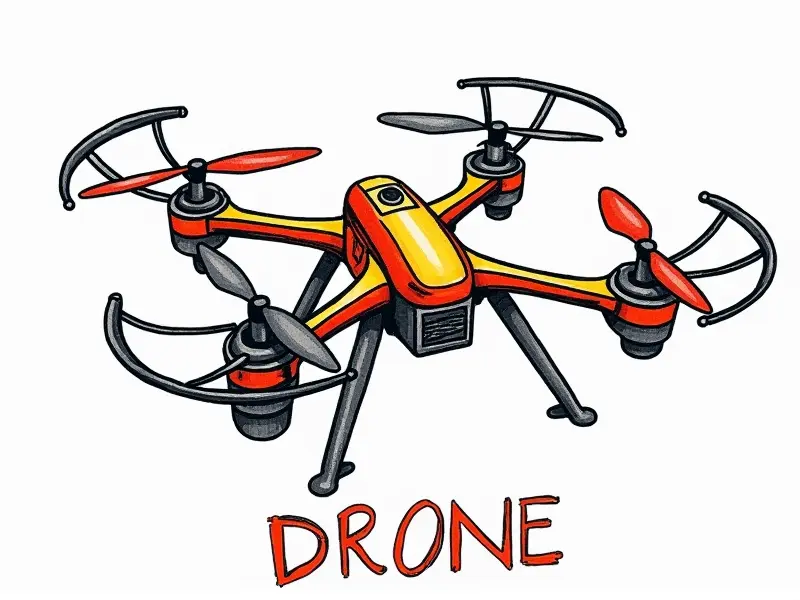What's a drone controller?

Everything You Need to Know About Drone Controllers
Welcome to our comprehensive guide on drone controllers! Whether you're a beginner or an experienced pilot, understanding the intricacies of a drone controller is crucial for optimal performance and enjoyment. In this article, we'll cover everything from basic functions to advanced features, helping you make informed decisions when selecting your next drone controller.
Beginner's Guide to Drone Controllers
If you're new to drones, the concept of a drone controller might seem daunting at first. However, with this beginner's guide, we aim to demystify it for you. A drone controller is essentially a remote control device that allows you to operate your unmanned aerial vehicle (UAV) from the ground.
Controllers typically consist of two sticks: one for pitch and roll (left stick), and another for throttle and yaw (right stick). These controls enable precise maneuvering, making it possible to navigate through tight spaces or capture stunning aerial footage. Additionally, modern controllers often come equipped with additional buttons for camera control, return-to-home functions, and more.
Understanding Drone Controller Functions
The primary function of a drone controller is to provide pilots with intuitive controls over their UAV's movements. By manipulating the sticks and buttons on the controller, you can adjust various parameters such as altitude, speed, direction, and camera angles. This allows for smooth flight operations and enhances your ability to capture high-quality aerial footage.
Moreover, drone controllers often include features like return-to-home (RTH) functionality, which automatically guides the drone back to its launch point in case of signal loss or battery depletion. Other useful functions might include obstacle avoidance systems, GPS stabilization, and intelligent flight modes designed for specific scenarios such as aerial photography or FPV racing.
How Does a Drone Controller Work?
A drone controller operates on the principle of radio frequency (RF) communication between the transmitter (controller) and receiver (drone). When you move the sticks or press buttons on your controller, signals are sent to the drone via RF waves. The onboard receiver then interprets these signals, translating them into commands that control the drone's motors, servos, and other components.
Modern controllers often utilize 2.4GHz or 5.8GHz frequencies for transmission, offering a balance between range and interference resistance. Additionally, some high-end models incorporate advanced technologies like digital signal processing (DSP) to enhance signal clarity and reduce lag, ensuring smooth and responsive control over your drone.
Essential Features of Drone Controllers
When selecting a drone controller, there are several key features you should consider:
- Built-in GPS: Provides stable flight and easy navigation.
- Return-to-Home (RTH): Ensures safe return of the drone in case of signal loss or low battery.
- Obstacle Avoidance Systems: Helps prevent collisions with obstacles during flight.
- Vibration-Free Sticks: Enhances control precision and reduces fatigue during long flights.
- Battery Life: Long-lasting batteries ensure uninterrupted flying sessions.
Choosing the Right Drone Controller
The right drone controller depends on your specific needs and preferences. For beginners, simplicity and ease of use are paramount. Look for controllers with clear labeling, intuitive controls, and user-friendly interfaces. Advanced users might prioritize features like high-frequency bands, extended range, or specialized modes designed for competitive racing.
Top Drone Controllers for Beginners
Selecting the best drone controller for beginners can be challenging due to the plethora of options available. Here are some top picks:
- DJI Tello Edu Controller: Perfect for educational purposes, offering easy-to-use controls and robust features.
- Hubsan X4 H107D RC Transmitter: Affordable and user-friendly with a wide range of functions suitable for beginners.
- TBS Crossfire 2.4GHz/5.8GHz Controller: Reliable performance and long-range capabilities make it ideal for both beginners and experienced pilots.
Maximizing Performance with Advanced Drone Controllers
For those looking to take their drone flying to the next level, advanced controllers offer cutting-edge features that enhance control precision and overall performance. These controllers often come equipped with multiple frequency bands for reduced interference, high-resolution screens for real-time video feedback, and specialized modes tailored to specific use cases.
Best Drone Controllers for Beginners
If you're just starting out in the world of drones, it's crucial to choose a controller that offers ease of use without compromising on essential features. Consider controllers like:
- DJI Tello Edu Controller: Ideal for educational purposes and beginner-friendly.
- Hubsan X4 H107D RC Transmitter: Affordable yet feature-rich, making it a great choice for beginners.
Drone Controller vs Smartphone Control
While many modern drones can be controlled via smartphones or tablets using dedicated apps, traditional controllers offer several advantages. Controllers provide tactile feedback and more intuitive control over flight dynamics, which is especially important when performing complex maneuvers. However, smartphone controls are convenient for casual use and offer additional features like live streaming and video editing.
Types of RC Transmitters Explained
The world of radio-controlled (RC) transmitters is diverse, catering to various needs and preferences:
- Analog Controllers: Simple and cost-effective but prone to interference.
- Digital Controllers: Offer superior signal clarity and reduced lag, making them ideal for advanced users.
- Multi-Frequency Controllers: Support multiple frequency bands for better range and reliability.
Conclusion
In conclusion, understanding the nuances of drone controllers is essential for anyone venturing into the world of unmanned aerial vehicles. Whether you're a beginner looking to ease into the hobby or an experienced pilot seeking top-tier performance, choosing the right controller can significantly enhance your flying experience.
This guide has provided insights into various aspects of drone controllers, from basic functions and features to advanced options tailored for competitive racing and professional photography. We hope this information helps you make informed decisions when selecting your next drone controller.

